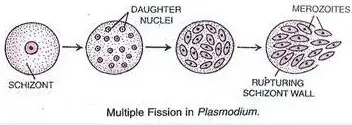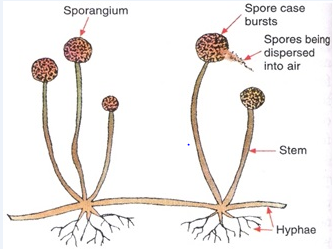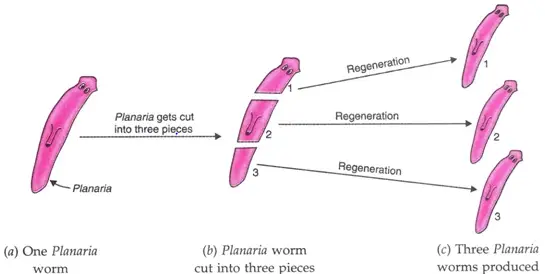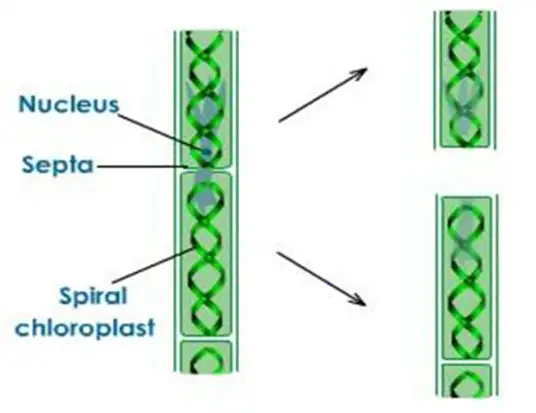Reproduction in living organisms
Reproduction:
The production of new organism from the existing organism of the same species is called reproduction.Reproduction is essential for the survival of species on this earth. The process of reproduction ensure continuity of life on earth. Reproduction give rise to more organism with the same basic characteristics as their parents.
Types of Reproduction
There are two main methods of reproduction in living.- asexual reproduction.
- Sexual reproduction.
The production of new organism from a single parent without the involvement of sex cells (or gametes) is called asexual reproduction.
Sexual Reproduction
The process of production of new organism from two parents by making use of sex cells.
Methods of Asexual Reproduction
-It takes place by 6 methods.
- Fission
- Budding
- Spore formation
- Regeneration
- Fragmentation
- Vegetative Propagation
(1) Fission
In the process of fission a unicellular organism split to form two or more new organism. It is of two types.Binary fission:
In Binary Fission , the parent organism splits to form two new organisms for example- Amoeba, Paramecium Leishmania, Bacteria etc are reproduce by binary fission.When the amoeba cell has reached its maximum size of growth, then first the nucleus of amoeba lengthen and divide into two parts after that cytoplasm of parent amoeba divides to form two smaller daughter amoeboe .
In amoeba fission take place in any plane but in Leihsmania splitting of parent cell during fission takes place in definite place longitudinal with respect to flagellum at its end.
Multiple Fission
In multiple fission the parent organism splits to form many new organisms at same time. For example: Plasmodium.
Some organisms during unfavorable condition a cyst or protective wall is formed around the cell of plasmodium. Inside the cyst the nucleus of cell splits several time to form many daughter nuclei and then cytoplasm collect around each daughter nuclei and thin membrane are form so many new daughter cells are form with in a cyst. When a favorable conditions arrive the cyst breaks open and daughter cells are released each farming a new organism.
(2) Budding
In budding a small part of a body of parent organism grows out as a bud which then detaches and become a new organism.For Example: Hydra, yeast reproduce by budding.

In Hydra a small out growth (bud) is formed on the sites of its body by the repeated mitotic division of its cell. This bud then grows gradually by developing mouth and tentacles and then tiny new hydra detaches itself from parent organism and lives as a separate organism.
(3) Spore Formation:
In spare formation, the parent plant produces 100 of microscopic reproductive units called “spores” with in the spore case. When the spore case burst, then the spores spread into air. When these air borne spores land on food or soil, under favorable condition they germinate and produce new plants for example: Most of the fungi such as Rhizopus ( bread mould) ,mucor, bacteria, non-flowering plants, ferns and mosses.The common bread mould plant (rhizopus) consists of thread like hyphae and thin stretch having knob like sporangium which contains 100 of spores enclosed in spore-case. When the spore case burst, then the spores spread into air. When these air borne spores land on food or soil, under favorable condition they germinate and produce new plants.

(4) Regeneration:
The process of getting back off full organism from its body part is called regeneration. For example simple animals like Hydra and Planaria show regeneration.Planaria (Flatworm) is found in freshwater ponds. If the body of planaria somehow gets cut into number of pieces then each body piece can regenerate into complete planaria.


it occurs by the process of growth and development. The cells of cut body part divide rapidly to make ball of cells. The cells present in ball of cells move to their proper places and form various organs and body parts of an organisms.
Why multicellular complex organism cannot show power of regeneration?
In multicellular complex organism, specialized cells makes up tissue, tissue makes up organ, organ makes up organ system and finally organ system makes up organism. They have a high degree of organization in their body so they cannot reproduce their body through regeneration.
How will an organism benefited if it reproduce through spores?
The reproduction by spores take place in plants. Spores are covered by hard protective coat which enables them to survive under unfavorable conditions, like lack of food, lack of water and extreme temperature but when the conditions are favorable the spores can grow to produce new plants. Thus, the reproduction by spores benefits the plant because by surviving under adverse conditions, the spores make these plants live forever.
(5) Fragmentation:
The breaking up of body of simple multicellular organism into two or more fragments or maturing, each of which subsequently grows to form a new complete organism is known as fragmentation.Spirogyra is a green filamentous algae. Spirogyra breaks into two or more fragments on maturing and each fragments then grows into new spirogyra.

(6) Vegetative reproduction (Vegetative propagation):
In vegetative propagation new plants are obtain from the parts of old plants (stem, leaves, or root) without the help of any reproductive organ.Natural methods of vegetative propagation:
The green grass grows in the field after rain from the dry, old stem of grass plant present in the field by the method of vegetative propagation.
Bryophyllum plants can be reproduce by vegetative propagation by using leaves.
| Plant | Vegetative propogule |
| Potato | Potato tuber (stem) |
| Begonia | Leaves |
| Money plant | Stem |
vegetative propagation usually involves the growth and development of one or more buds present on the old part of the plant to form a new plant.
Artificial method of vegetative propagation: The process of growing many plants from one plant by man made method is called vegetative propagation.
Cutting:
A small part of plant which is removed by making a cut with sharp knife is called cutting. A cut may be a piece of stem, root or leaves. For example-The plant like rose, sugarcane, cactus are grown by cutting. It is necessary that there are some buds on it.
Layering:
In this method a branch of plant is pulled towards the ground and a part of it is covered with moist soil leaving the tip of branch exposed above the ground. after some time new roots develop and then it cut off from parent plant and grows as new plant. for example- Jasmine, strawberry, hibiscus and guava etc.
Grafting:
It is the method in which the cut stem of two different plant one with root and other without root and joined together in such a way that the two stem joint and grows as a single plant. This new plant has the characteristics of both the plants.
The cut stem of plant having root is called stock and the cut stem of another plant is called scion. For example- Apple, peach, apricot, pear etc.
Advantages of vegetative propagation:
- The new plant produced by artificial vegetative propagation will be exactly like parent plant.
- The fruit trees grown from cutting or grafting start to bear fruits much earlier.
- Many plants can be grown from just one parent plant.
- We can also get seedless plant by artificial propagation.
Tissue culture (Micro propagation):
The production of new plants from a small piece of plant tissue removed from a growing tip of plant in a suitable growth medium (culture or jelly like synthetic medium) is called tissue culture.Procedure:
- The tissue is placed on a culture medium which contain nutrients and plant hormones, which make the cells in the plant tissue to divide rapidly o form callus.
- This callus is transfer to another medium containing plant hormone which stimulates the callus to develop roots.
- Then it is put on another medium containing another plant hormone which stimulates the development of shoot.
- The plantlets are then transplanted into soil where they can grow to form mature plant. This technique is used to the production of ornamental plants like orchids, carnation etc.
Advantages:
- It is a very fast technique.
- New plant produced by tissue culture are disease free.
- Very little space is needed.
- By this method plants can be grown around the year irrespective of weather or seasons.
Introduction to reproduction in plants
- The production of new organism from two parents by making use of their sex cells (called gametes) is called sexual reproduction.
- In sexual reproduction, a male gamete fuses with a female gamete to form a new cell called zygote. This zygote then grows and develops into a new organism in due course of time.
- (The cells involved in sexual reproduction are called sex cells or gametes or germ cells)
Sexual reproduction in Flowering plants:
- The plants in which the sex organs are carried within the flowers and the seeds are enclosed in a fruit are called angiosperms (flowering plants).
- The flowering plants are reproduced by sexual reproduction method.
- The function of a flower is to make male and female gametes and to ensure that fertilisation will take place to make new seeds for the reproduction of plant.
The main parts of flower are:
- Receptacle: The base of a flower to which all the parts of a flower are attached is called receptacle.
- Sepals (group name calyx): Sepals are green outermost leaf-like floral organs which protect the flower in the bud stage.
- Petals (group name corolla): The colorful parts of a flower are called petals. The petals lie inside the sepals.
Petals attract insects to flowers for pollination. They also provide protection to centrally placed reproductive organs. - Stamen: Stamen is the male reproductive part and it produces pollen grains that are yellowish in color.
The stalk of stamen is called filament and the swollen top of stamen is called anther. The anther of stamen makes the pollen grains and stores them. - Carpel: Carpel is present in the centre of a flower and is the female reproductive part.
It is made up of three parts. The swollen bottom part is ovary, middle elongated part is the style and the terminal part which may be sticky is the stigma.
The ovary contains ovules and each ovule has an egg cell.
The flowers which contain only sex organ, either stamens or carpels are called unisexual flower. For example: papaya and watermelon plants
The flowers which contain both the sex organs, stamens as well as carpel, are called bisexual flowers. For example: Hibiscus and mustard plants.
A new seed of the plant is formed when the male gamete in a pollen grain unites with the female gametes present in the ovule.
Pollination:
- The transfer of pollen grains from the anther of a stamen to the stigma of a carpel is called pollination.
- If the transfer of pollen occurs in the same flower or another flower on the same plant, it is called self-pollination.
- If the pollen is transferred from the anther of a flower on one plant to the stigma of a flower on another similar plant, it is called cross-pollination.
- Pollination is done by insects, birds, winds and water.
Fertilization:
Fertilization occurs when the male gamete present in pollen grain joins with the female gametes present in ovule.- A male gamete moves down the pollen tube. The pollen tube enters the ovule in the ovary. The tip of pollen tube bursts open and male gamete comes out of pollen tube.
- In ovary, the male gamete of pollen combines with the nucleus of female gamete or egg present in ovule to form a fertilized egg called zygote.
- After fertilization, the zygote divides several times to form an embryo within the ovule. The ovule develops a tough coat and is gradually converted into a seed.
- The ovary grows rapidly and ripens to form a fruit. The other parts of flower like sepals, petals, stamen, stigma and style dry up and fall off.
- The part of baby plant in see which develops into shoot with leaves is called plumule and part which develops into root is called radicle. The part of seed which contains stored food for the baby plant is called cotyledons.
- When the seed gets suitable conditions like water, air warmth etc., it germinates and a new plant grows out of the seed.



